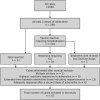Refractory Anaphylaxis: Data From the European Anaphylaxis Registry
- PMID: 31749797
- PMCID: PMC6842952
- DOI: 10.3389/fimmu.2019.02482
Refractory Anaphylaxis: Data From the European Anaphylaxis Registry
Abstract
Refractory anaphylaxis (unresponsive to treatment with at least two doses of minimum 300 μg adrenaline) is a rare and often fatal hypersensitivity reaction. Comprehensive data on its definition, prevalence, and risk factors are missing. Using the data from the European Anaphylaxis Registry (11,596 cases in total) we identified refractory anaphylaxis cases (n = 42) and analyzed these in comparison to a control group of severe anaphylaxis cases (n = 4,820). The data show that drugs more frequently elicited refractory anaphylaxis (50% of cases, p < 0.0001) compared to other severe anaphylaxis cases (19.7%). Cases elicited by insects (n = 8) were more often due to bees than wasps in refractory cases (62.5 vs. 19.4%, p = 0.009). The refractory cases occurred mostly in a perioperative setting (45.2 vs. 9.05, p < 0.0001). Intramuscular adrenaline (as a first line therapy) was administered in 16.7% of refractory cases, whereas in 83.3% of cases it was applied intravenously (significantly more often than in severe anaphylaxis cases: 12.3%, p < 0.0001). Second line treatment options (e.g., vasopression with dopamine, methylene blue, glucagon) were not used at all for the treatment of refractory cases. The mortality rate in refractory anaphylaxis was significantly higher (26.2%) than in severe cases (0.353%, p < 0.0001). Refractory anaphylaxis is associated with drug-induced anaphylaxis in particular if allergens are given intravenously. Although physicians frequently use adrenaline in cases of perioperative anaphylaxis, not all patients are responding to treatment. Whether a delay in recognition of anaphylaxis is responsible for the refractory case or whether these cases are due to an overflow with mast cell activating substances-requires further studies. Reasons for the low use of second-line medication (i.e., methylene blue or dopamine) in refractory cases are unknown, but their use might improve the outcome of severe refractory anaphylaxis cases.
Keywords: adrenaline (epinephrine); anaphylaxis; beta-blockers; drug allergic reactions; insect venom allergy; refractory; vasoconstriction.
Copyright © 2019 Francuzik, Dölle-Bierke, Knop, Scherer Hofmeier, Cichocka-Jarosz, García, Lang, Maris, Renaudin and Worm.
Figures


References
-
- Sampson HA, Muñoz-Furlong A, Campbell RL, Adkinson NF, Bock SA, Branum A, et al. . Second symposium on the definition and management of anaphylaxis: summary report - Second National Institute of Allergy and Infectious Disease/Food Allergy and Anaphylaxis Network Symposium. Ann Emerg Med. (2006) 47:373–80. 10.1016/j.annemergmed.2006.01.018 - DOI - PubMed
Publication types
MeSH terms
LinkOut - more resources
Full Text Sources
Medical

